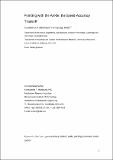Pointing with the ankle: the speed-accuracy trade-off
Author(s)
Michmizos, Konstantinos; Krebs, Hermano Igo
Download221_2013_3773_ReferencePDF.pdf (563.8Kb)
PUBLISHER_POLICY
Publisher Policy
Article is made available in accordance with the publisher's policy and may be subject to US copyright law. Please refer to the publisher's site for terms of use.
Terms of use
Metadata
Show full item recordAbstract
This study investigated the trade-off between speed and accuracy in pointing movements with the ankle during goal-directed movements in dorsal–plantar (DP) and inversion–eversion (IE). Nine subjects completed a series of discrete pointing movements with the ankle between spatial targets of varying difficulty. Six different target sets were presented, with a range of task difficulty between 2.2 and 3.8 bits of information. Our results demonstrated that for visually evoked, visually guided discrete DP and IE ankle pointing movements, performance can be described by a linear function, as predicted by Fitts’ law. These results support our ongoing effort to develop an adaptive algorithm employing the speed-accuracy trade-off concept to control our pediatric anklebot while delivering therapy for children with cerebral palsy.
Date issued
2013-11Department
Massachusetts Institute of Technology. Department of Mechanical Engineering; McGovern Institute for Brain Research at MITJournal
Experimental Brain Research
Publisher
Springer Berlin Heidelberg
Citation
Michmizos, Konstantinos P., and Hermano Igo Krebs. “Pointing with the Ankle: The Speed-Accuracy Trade-Off.” Experimental Brain Research 232, no. 2 (November 23, 2013): 647–657.
Version: Author's final manuscript
ISSN
0014-4819
1432-1106